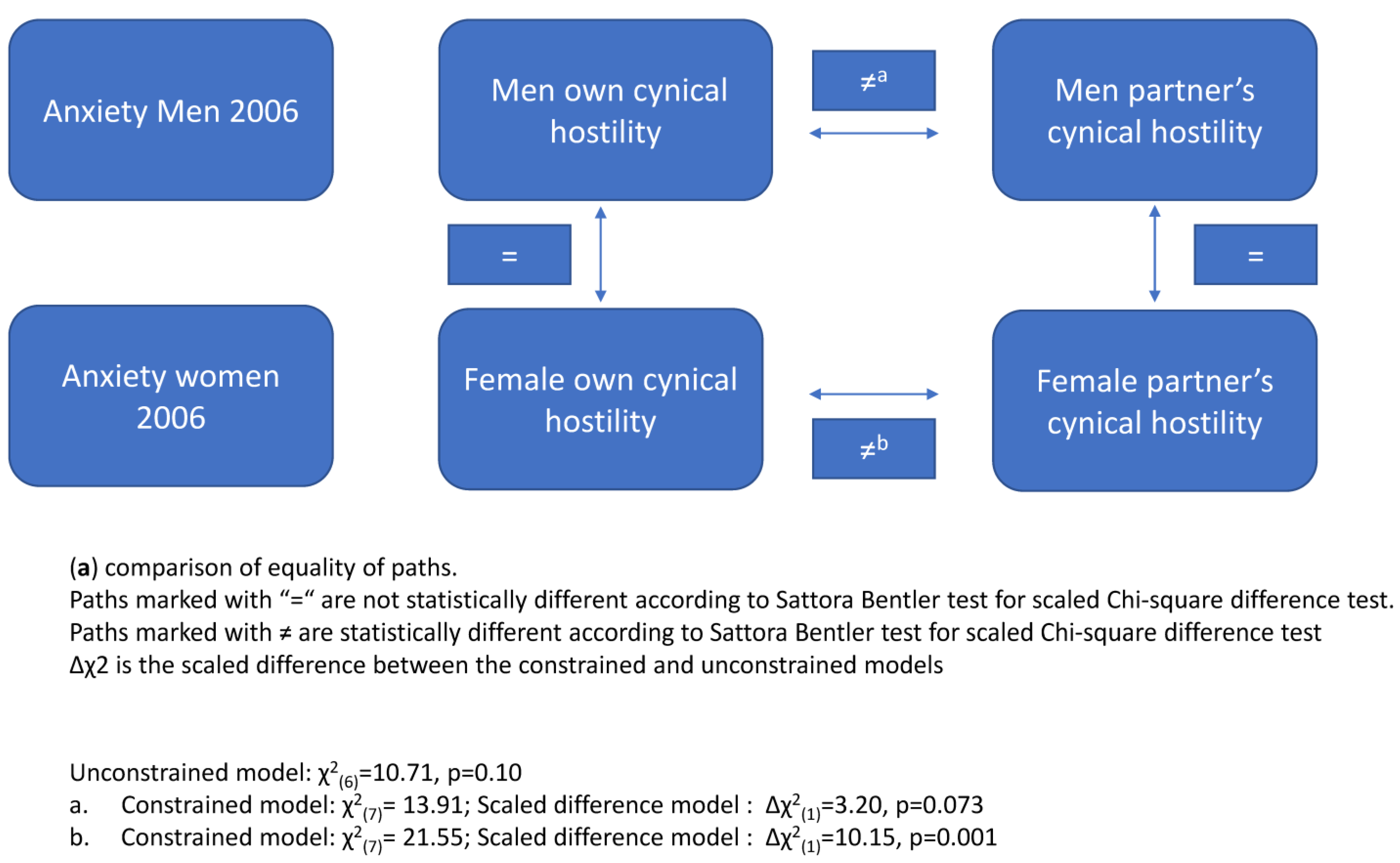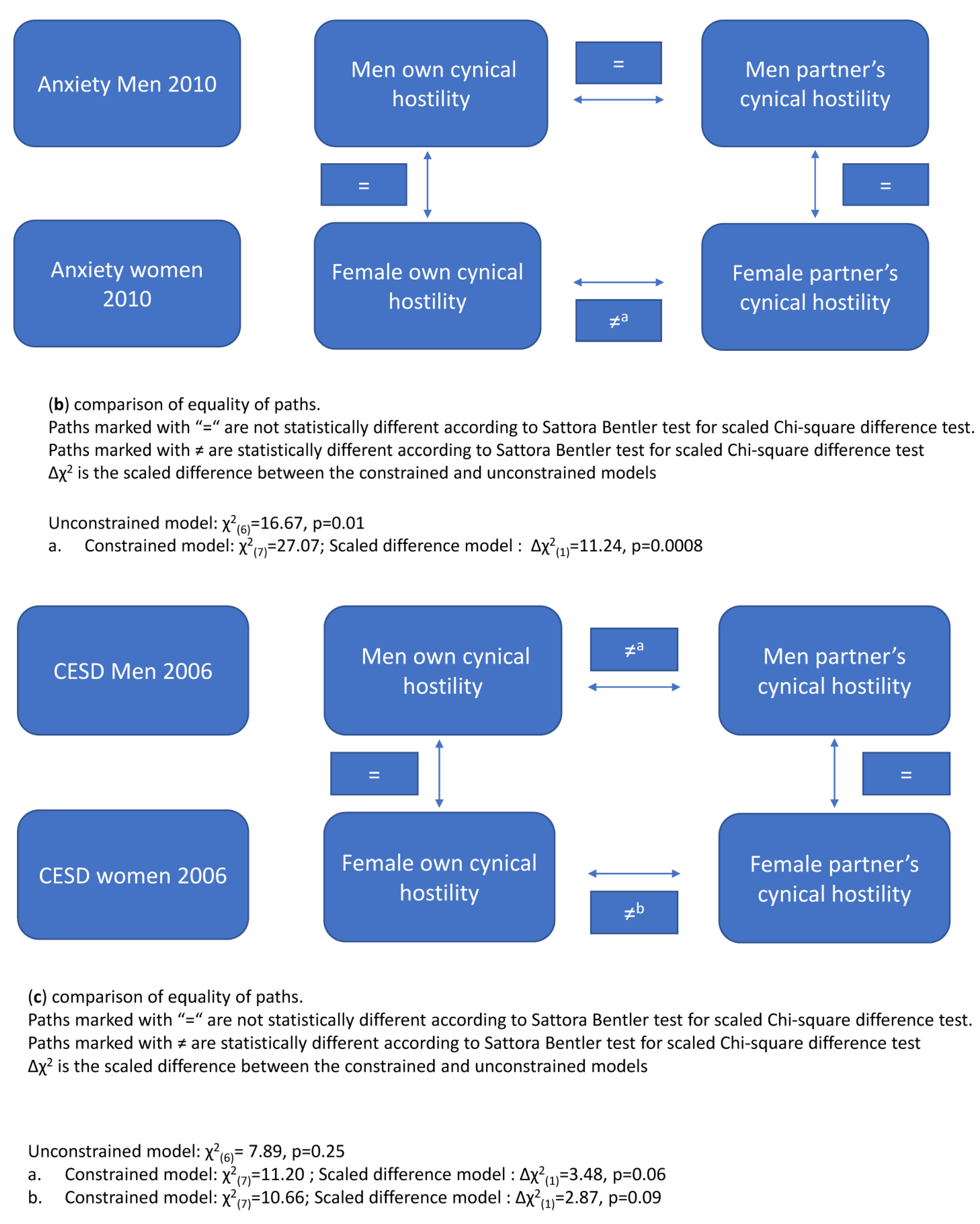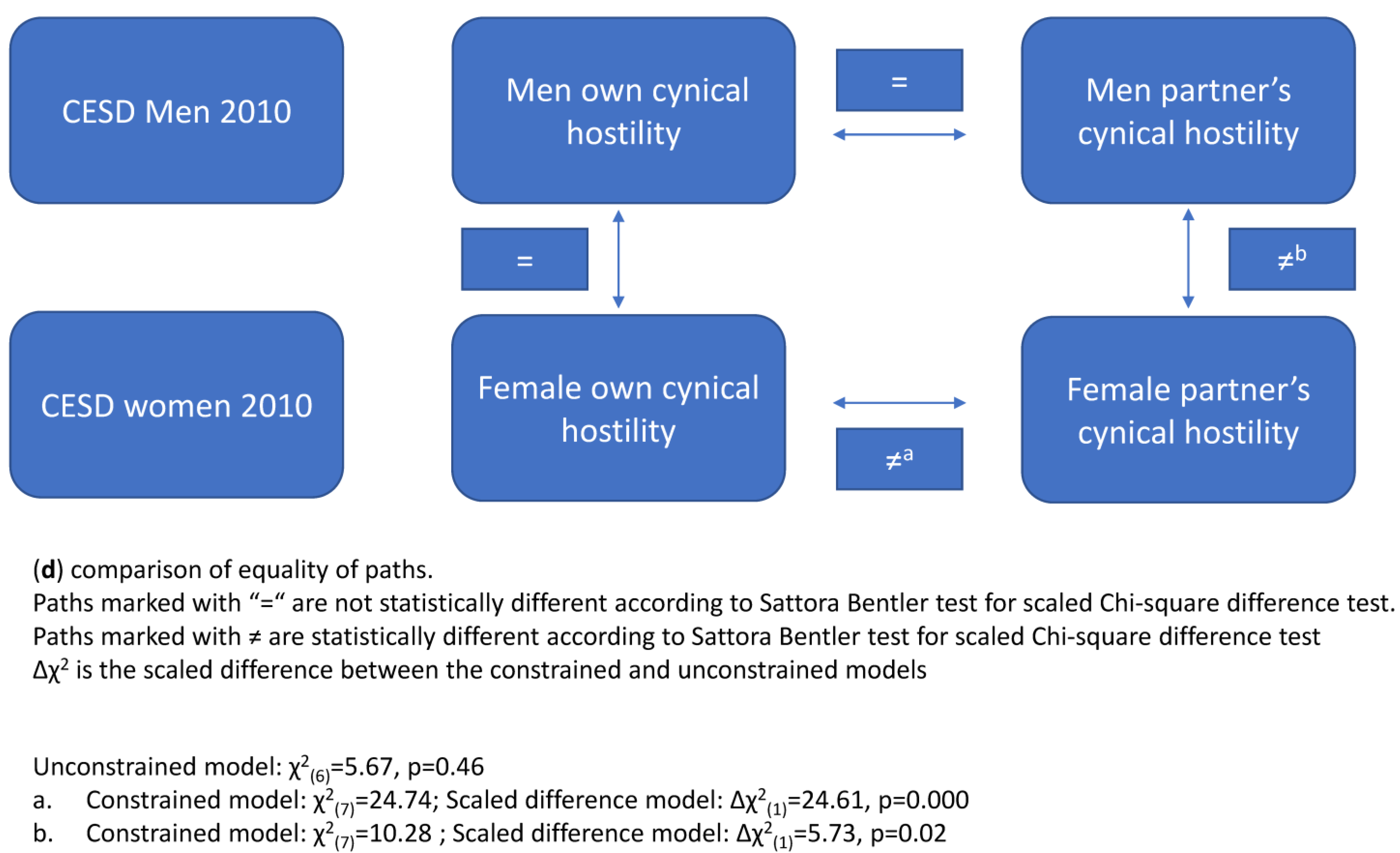Links between Couples’ Cynical Hostility and Mental Health: A Dyadic Investigation of Older Couples
Abstract
1. Introduction
1.1. Cynical Hostility
1.2. Cynical Hostility in Close Relationships
2. Materials and Methods
2.1. Participants
2.2. Measures
2.2.1. Anxiety Symptoms
2.2.2. Depressive Symptoms
2.2.3. Cynical Hostility
2.2.4. Covariates
2.3. Analysis
3. Results
3.1. Cross-Sectional Results of APIM for T1 (2006)
3.2. Cross-Sectional Results for T2 (2010)
4. Discussion
Limitations and Future Research
Author Contributions
Funding
Institutional Review Board Statement
Informed Consent Statement
Data Availability Statement
Conflicts of Interest
References
- Smith, T.W.; Glazer, K.; Ruiz, J.M.; Gallo, L.C. Hostility, anger, aggressiveness, and coronary heart disease: An interpersonal perspective on personality, emotion, and health. J. Pers. 2004, 72, 1217–1270. [Google Scholar] [CrossRef]
- Segel-Karpas, D.; Ayalon, L. Loneliness and Hostility in Older Adults: A Cross-Lagged Model. Psychol. Aging 2009, 35, 169–181. [Google Scholar] [CrossRef]
- Stavrova, O.; Ehlebracht, D.; Vohs, K.D. Victims, perpetrators, or both? The vicious cycle of disrespect and cynical beliefs about human nature. J. Exp. Psychol. Gen. 2020, 149, 1736–1754. [Google Scholar] [CrossRef]
- Segel-Karpas, D.; Ermer, A. Cynical hostility and loneliness in older adult married couples: An indirect effect through friendships. J. Gerontol. Ser. B 2021, 76, 306–316. [Google Scholar] [CrossRef]
- Smith, T.W. Concepts and methods in the study of anger, hostility, and health. In Anger, Hostility, and the Heart; Siegman, A.W., Smith, T.W., Eds.; Lawrence Erlbaum Associates: Hillsdale, NJ, USA, 1994; pp. 23–42. [Google Scholar]
- King, K. Aggravating conditions: Cynical hostility and neighborhood ambient stressors. Soc. Sci. Med. 2012, 75, 2258–2266. [Google Scholar] [CrossRef][Green Version]
- Segel-Karpas, D. Cynical hostility, social relationships, and loneliness in older adulthood. In Handbook of Anger, Aggression, and Violence; Martin, C.R., Preedy, V.R., Patel, V.B., Eds.; Springer International Publishing: Cham, Switzerland, 2022; pp. 1–15. [Google Scholar]
- Hakulinen, C.; Jokela, M.; Hintsanen, M.; Pulkki-Råback, L.; Hintsa, T.; Merjonen, P.; Josefsson, K.; Kähönen, M.; Raitakari, O.T.; Keltikangas-Järvinen, L. Childhood family factors predict developmental trajectories of hostility and anger: A prospective study from childhood into middle adulthood. Psychol. Med. 2013, 43, 2417–2426. [Google Scholar] [CrossRef]
- Merjonen, P.; Pulkki-Råback, L.; Lipsanen, J.; Lehtimäki, T.; Rontu, R.; Viikari, J.; Hintsanen, M.; Keltikangas-Järvinen, L. Development of adulthood hostile attitudes: Childhood environment and serotonin receptor gene interactions. Pers. Relationships 2011, 18, 184–197. [Google Scholar] [CrossRef]
- Chida, Y.; Steptoe, A. The association of anger and hostility with future coronary heart disease: A meta-analytic review of prospective evidence. J. Am. Coll. Cardiol. 2009, 53, 936–946. [Google Scholar] [CrossRef]
- Kubzansky, L.D.; Sparrow, D.; Jackson, B.; Cohen, S.; Weiss, S.T.; Wright, R.J. Angry breathing: A prospective study of hostility and lung function in the Normative Aging Study. Thorax 2006, 61, 863–868. [Google Scholar] [CrossRef][Green Version]
- Klabbers, G.; Bosma, H.; van den Akker, M.; Kempen, G.I.J.M.; van Eijk, J.T.M. Cognitive hostility predicts all-cause mortality irrespective of behavioural risk at late middle and older age. Eur. J. Public Health 2013, 23, 701–705. [Google Scholar] [CrossRef]
- Tindle, H.A.; Chang, Y.-F.; Kuller, L.H.; Manson, J.E.; Robinson, J.G.; Rosal, M.C.; Siegle, G.J.; Matthews, K.A. Optimism, cynical hostility, and incident coronary heart disease and mortality in the Women’s Health Initiative. Circulation 2009, 120, 656–662. [Google Scholar] [CrossRef] [PubMed]
- Brissette, I.; Cohen, S. The contribution of individual differences in hostility to the associations between daily interpersonal conflict, affect, and sleep. Pers. Soc. Psychol. Bull. 2002, 28, 1265–1274. [Google Scholar] [CrossRef]
- Taylor, N.D.; Fireman, G.D.; Levin, R. Trait Hostility, perceived stress, and sleep quality in a sample of normal sleepers. Sleep Disord. 2013, 2013, 735812. [Google Scholar] [CrossRef] [PubMed]
- Siegler, I.C.; Costa, P.T.; Brummett, B.H.; Helms, M.J.; Barefoot, J.C.; Williams, R.B.; Dahlstrom, W.G.; Kaplan, B.H.; Vitaliano, P.P.; Nichaman, M.Z.; et al. Patterns of change in hostility from college to midlife in the UNC alumni heart study predict high-risk status. Psychosom. Med. 2003, 65, 738–745. [Google Scholar] [CrossRef][Green Version]
- Heponiemi, T.; Elovainio, M.; Kivimäki, M.; Pulkki, L.; Puttonen, S.; Keltikangas-Järvinen, L. The longitudinal effects of social support and hostility on depressive tendencies. Soc. Sci. Med. 2006, 63, 1374–1382. [Google Scholar] [CrossRef] [PubMed]
- Mook, J.; Van Der Ploeg, H.M.; Kleijn, W.C. Anxiety, anger and depression: Relationships at the trait level. Anxiety Res. 1990, 3, 17–31. [Google Scholar] [CrossRef]
- Stewart, J.C.; Fitzgerald, G.J.; Kamarck, T.W. Hostility now, depression later? Longitudinal associations among emotional risk factors for coronary artery disease. Ann. Behav. Med. 2010, 39, 258–266. [Google Scholar] [CrossRef] [PubMed]
- Pincus, A.; Ansell, E.; Weiner, I. Interpersonal theory of personality. In Handbook of Psychology, Personality and Social Psychology; Millon, T., Lerner, M.J., Eds.; John Wiley & Sons: Hoboken, NJ, USA, 2003; Volume 5, pp. 209–253. [Google Scholar]
- Sullivan, H.S. The Interpersonal Theory of Psychiatry, 1st ed.; Routledge: New York, NY, USA, 1953. [Google Scholar] [CrossRef]
- Akyunus, M.; Gültekin, B.F. Representations of the early maladaptive schemas on the interpersonal circumplex. Int. J. Cogn. Ther. 2023, 16, 161–178. [Google Scholar] [CrossRef]
- Hardy, J.D.; Smith, T.W. Cynical hostility and vulnerability to disease: Social support, life stress, and physiological response to conflict. Health Psychol. 1988, 7, 447–459. [Google Scholar] [CrossRef]
- Segel-Karpas, D. Older parents’ cynical hostility and their relationships with their adult children: A longitudinal dyadic study of North American couples. Healthcare 2023, 11, 736. [Google Scholar] [CrossRef]
- Smith, T.W.; Pope, M.K.; Sanders, J.D.; Allred, K.D.; O’Keeffe, J.L. Cynical hostility at home and work: Psychosocial vulnerability across domains. J. Res. Pers. 1988, 22, 525–548. [Google Scholar] [CrossRef]
- Holt-Lunstad, J.; Smith, T.W.; Uchino, B.N. Can hostility interfere with the health benefits of giving and receiving social support? the impact of cynical hostility on cardiovascular reactivity during social support interactions among friends. Ann. Behav. Med. 2008, 35, 319–330. [Google Scholar] [CrossRef] [PubMed]
- Lepore, S.J. Cynicism, social support, and cardiovascular reactivity. Health Psychol. 1995, 14, 210–216. [Google Scholar] [CrossRef] [PubMed]
- Christensen, A.J.; Smith, T.W. Cynical hostility and cardiovascular reactivity during self-disclosure. Psychosom. Med. 1993, 55, 193–202. [Google Scholar] [CrossRef] [PubMed]
- Bowen, M. Family Therapy in Clinical Practice, 1st ed.; Jason Aronson Inc.: Lanham, MD, USA, 1993. [Google Scholar]
- Miller, T.Q.; Markides, K.S.; Chiriboga, D.A.; Ray, L.A. A test of the psychosocial vulnerability and health behavior models of hostility: Results from an 11-year follow-up study of Mexican Americans. Psychosom. Med. 1995, 57, 572–581. [Google Scholar] [CrossRef] [PubMed]
- Smith, T.W.; Sanders, J.D.; Alexander, J.F. What does the Cook and Medley Hostility scale measure? Affect, behavior, and attributions in the marital context. J. Pers. Soc. Psychol. 1990, 58, 699–708. [Google Scholar] [CrossRef] [PubMed]
- Baron, K.G.; Smith, T.W.; Butner, J.; Nealey-Moore, J.; Hawkins, M.W.; Uchino, B.N. Hostility, anger, and marital adjustment: Concurrent and prospective associations with psychosocial vulnerability. J. Behav. Med. 2007, 30, 1–10. [Google Scholar] [CrossRef] [PubMed]
- Brummett, B.H.; Barefoot, J.C.; Feaganes, J.R.; Yen, S.; Bosworth, H.B.; Williams, R.B.; Siegler, I.C. Hostility in marital dyads: Associations with depressive symptoms. J. Behav. Med. 2000, 23, 95–105. [Google Scholar] [CrossRef]
- Szymczak, P.; Sawicki, A.; Jaworski, M. How narcissists see the social world? Trust, cynicism, and trifurcated model of narcissism. Curr. Psychol. 2020, 41, 7105–7113. [Google Scholar] [CrossRef]
- Estlein, R.; Theiss, J.A. Responsiveness and control in marital and parental communication: Exploring interdependent relationships across family subsystems. J. Fam. Stud. 2022, 28, 968–985. [Google Scholar] [CrossRef]
- Kurylo, M.; Gallant, S. Hostility and cardiovascular reactivity in women during self-disclosure. Int. J. Behav. Med. 2000, 7, 271–285. [Google Scholar] [CrossRef]
- Laurenceau, J.-P.; Barrett, L.F.; Rovine, M.J. The Interpersonal Process Model of Intimacy in Marriage: A Daily-diary and multilevel modeling approach. J. Fam. Psychol. 2005, 19, 314–323. [Google Scholar] [CrossRef] [PubMed]
- Pietromonaco, P.R.; Overall, N.C.; Powers, S.I. Depressive symptoms, external stress, and marital adjustment: The buffering effect of partner’s responsive behavior. Soc. Psychol. Personal. Sci. 2022, 13, 220–232. [Google Scholar] [CrossRef] [PubMed]
- Guyll, M.; Cutrona, C.; Burzette, R.; Russell, D. Hostility, relationship quality, and health among African American couples. J. Consult. Clin. Psychol. 2010, 78, 646–654. [Google Scholar] [CrossRef]
- Ben-Ari, A.; Lavee, Y. Dyadic characteristics of individual attributes: Attachment, neuroticism, and their relation to marital quality and closeness. Am. J. Orthopsychiatry 2005, 75, 621–631. [Google Scholar] [CrossRef] [PubMed]
- Estlein, R.; Lavee, Y. Effect of daily stress on desire for physical proximity and emotional closeness. J. Fam. Issues 2022, 43, 1039–1067. [Google Scholar] [CrossRef]
- Carstensen, L.L. Social and emotional patterns in adulthood: Support for socioemotional selectivity theory. Psychol. Aging 1992, 7, 331–353. [Google Scholar] [CrossRef] [PubMed]
- Beck, A.T.; Epstein, N.; Brown, G.; Steer, R.A. An inventory for measuring clinical anxiety: Psychometric properties. J. Consult. Clin. Psychol. 1988, 56, 893–897. [Google Scholar] [CrossRef]
- Zohar, A.H.; Dahan, D. Young children’s ritualistic compulsive-like behavior and executive function: A cross sectional study. Child Psychiatry Hum. Dev. 2016, 47, 13–22. [Google Scholar] [CrossRef] [PubMed]
- Radloff, L.S. The CES-D scale: A self report depression scale for research in the general. Appl. Psychol. Meas. 1977, 1, 385–401. [Google Scholar] [CrossRef]
- Cook, W.W.; Medley, D.M. Proposed hostility and pharisaic-virtue scales for the MMPI. J. Appl. Psychol. 1954, 38, 414–429. [Google Scholar] [CrossRef]
- Contrada, R.J.; Jussim, L. What does the Cook-Medley Hostility Scale measure? In search of an adequate measurement model. J. Appl. Soc. Psychol. 1992, 22, 615–627. [Google Scholar] [CrossRef]
- Garcia, R.L.; Kenny, D.A.; Ledermann, T. Moderation in the actor–partner interdependence model. Pers. Relatsh. 2015, 22, 8–29. [Google Scholar] [CrossRef]
- Kenny, D.A. Reflections on the actor-partner interdependence model. Pers. Relatsh. 2018, 25, 160–170. [Google Scholar] [CrossRef]
- Hart, K.E.; Hope, C.W. Cynical hostility and the psychosocial vulnerability model of disease risk: Confounding effects of neuroticism (negative affectivity) bias. Pers. Individ. Differ. 2004, 36, 1571–1582. [Google Scholar] [CrossRef]
- Fuhrer, R.; Stansfeld, S. How gender affects patterns of social relations and their impact on health: A comparison of one or multiple sources of support from “close persons”. Soc. Sci. Med. 2002, 54, 811–825. [Google Scholar] [CrossRef] [PubMed]
- Rautiainen, E.-L.; Aaltonen, J. Depression: The differing narratives of couples in couple therapy. Qual. Rep. 2010, 15, 156–175. [Google Scholar] [CrossRef]
- Davidson, K. “Why can’t a man be more like a woman?”: Marital status and social networking of older men. J. Men’s Stud. 2004, 13, 25–43. [Google Scholar] [CrossRef]
- Gewirtz-Meydan, A.; Estlein, R.; Finzi-Dottan, R. The relationship between narcissistic traits and attitudes toward infidelity: A dyadic analysis. J. Fam. Psychol. 2023, 37, 932–941. [Google Scholar] [CrossRef]
- Brazão, N.; da Motta, C.; Rijo, D.; Salvador, M.D.C.; Pinto-Gouveia, J.; Ramos, J. Clinical change in cognitive distortions and core schemas after a cognitive–behavioral group intervention: Preliminary findings from a randomized trial with male prison inmates. Cogn. Ther. Res. 2015, 39, 578–589. [Google Scholar] [CrossRef]
- van Teffelen, M.W.; Voncken, M.J.; Peeters, F.; Mollema, E.D.; Lobbestael, J. The efficacy of incorporating mental imagery in cognitive restructuring techniques on reducing hostility: A randomized controlled trial. J. Behav. Ther. Exp. Psychiatry 2021, 73, 101677. [Google Scholar] [CrossRef] [PubMed]



| M | SD | 1 | 2 | 3 | 4 | 5 | 6 | 7 | 8 | 9 | 10 | 11 | |
|---|---|---|---|---|---|---|---|---|---|---|---|---|---|
| 1. Husbands’ cynical hostility 2006 | 3.13 | 1.11 | |||||||||||
| 2. Husbands’ anxiety 2006 | 1.46 | 0.51 | 0.24 *** | ||||||||||
| 3. Husbands’ depressive symptoms 2006 | 0.90 | 1.51 | 0.24 *** | 0.39 *** | |||||||||
| 4. Husbands’ cynical hostility 2010 | 3.02 | 1.11 | 0.59 *** | 0.19 *** | 0.22 *** | ||||||||
| 5. Husbands’ anxiety 2010 | 1.46 | 0.52 | 0.23 *** | 0.57 *** | 0.35 *** | 0.25 *** | |||||||
| 6. Husband’s depressive symptoms 2010 | 0.86 | 1.50 | 0.18 *** | 0.34 *** | 0.52 *** | 0.18 *** | 0.41 *** | ||||||
| 7. Wives’ cynical hostility 2006 | 2.72 | 1.08 | 0.33 *** | 0.16 *** | 0.17 *** | 0.26 *** | 0.15 *** | 0.13 *** | |||||
| 8. Wives’ anxiety 2006 | 1.52 | 0.53 | 0.14 *** | 0.23 *** | 0.16 *** | 0.12 *** | 00.17 *** | 0.15 *** | 0.25 *** | ||||
| 9. Wives’ depressive symptoms 2006 | 1.21 | 1.81 | 0.15 *** | 0.12 *** | 0.23 *** | 0.11 *** | 0.08 ** | 0.18 *** | 0.21 *** | 0.44 *** | |||
| 10. Wives’ cynical hostility 2010 | 2.66 | 1.06 | 0.28 *** | 0.14 *** | 0.15 *** | 0.28 *** | 0.17 *** | 0.17 *** | 0.58 *** | 0.25 *** | 0.20 *** | ||
| 11. Wives’ anxiety 2010 | 1.50 | 0.55 | 0.14 *** | 0.22 *** | 0.11 *** | 0.13 *** | 0.27 *** | 0.16 *** | 0.24 *** | 0.53 *** | 0.36 *** | 0.26 *** | |
| 12. Wives’ depressive symptoms 2010 | 1.11 | 1.74 | 0.15 *** | 0.15 *** | 0.18 *** | 0.09 *** | 0.14 *** | 0.21 *** | 0.21 *** | 0.36 *** | 0.54 *** | 0.26 *** | 0.46 *** |
| Overall Model Anxiety 1 | Moderation Effects Anxiety | Overall Model Depressive Symptoms 2 | Moderation Effects Depressive Symptoms | |||||
|---|---|---|---|---|---|---|---|---|
| Husbands | Wives | Husbands | Wives | Husbands | Wives | Husbands | Wives | |
| β/SE | β/SE | β/SE | β/SE | β/SE | β/SE | β/SE | β/SE | |
| Wife Race | 0.03/0.03 | 0.04/0.03 | 0.03/0.03 | 0.03/0.03 | ||||
| Husband Race | 0.01/0.03 | 0.01/0.03 | 0.03/0.03 | −0.03/0.03 | ||||
| Wife Age | −0.04/0.03 | −0.04/0.03 | −0.13 ***/0.03 | −0.13 ***/0.03 | ||||
| Husband Age | −0.04/0.03 | −0.04/0.03 | −0.11 ***/0.03 | −0.11 ***/0.03 | ||||
| Wife Self-Rated Health | −0.26 ***/0.03 | −0.25 ***/0.03 | −0.34 ***/0.03 | −0.34 ***/0.03 | ||||
| Husband Self-Rated Health | −0.25 ***/0.03 | −0.25 ***/0.03 | −0.30 ***/0.03 | −0.30 ***/0.03 | ||||
| Wife Cynical Hostility (WCH) | 0.06 */0.03 | 0.20 ***/0.03 | 0.07/0.08 | 0.15+/0.08 | 0.06 */0.03 | 0.12 ***/0.03 | 0.03/0.06 | −0.07/0.07 |
| Husband Cynical Hostility (HCH) | 0.16 ***/0.03 | 0.04/0.030 | 0.06 */0.08 | −0.003/0.07 | 0.16 ***/0.03 | 0.05/0.03 | 0.12+/0.07 | −0.01/0.08 |
| WCH × CH | −0.01/0.13 | 0.08 | 0.06/0.12 | 0.20/0.13 | ||||
| Model Fit | RMSEA = 0.025, CFI = 0.985, TLI = 0.985 | RMSEA = 0.025, CFI = 0.985, TLI = 0.981 | RMSEA = 0.016, CFI = 0.995, TLI = 0.986 | |||||
| Overall Model Anxiety | Moderation Effects Anxiety | Overall Model Depressive Symptoms | Moderation Effects Depressive Symptoms | |||||
|---|---|---|---|---|---|---|---|---|
| Husbands | Wives | Husbands | Wives | Husbands | Wives | Husbands | Wives | |
| β/SE | β/SE | β/SE | β/SE | β/SE | β/SE | β/SE | β/SE | |
| Wife Race | 0.04/0.03 | 0.04/0.03 | 0.006/0.03 | 0.01/0.03 | ||||
| Husband Race | 0.01/0.03 | 0.01/0.03 | −0.03/0.03 | −0.03/0.03 | ||||
| Wife Age | 0.03/0.03 | 0.03/0.03 | −0.03/0.03 | −0.03/0.03 | ||||
| Husband Age | −0.02/0.03 | −0.02/0.03 | −0.06 */0.03 | −0.05+/0.03 | ||||
| Wife Self-Rated Health | −0.25 ***/0.03 | −0.25 ***/0.03 | −0.29 ***/0.03 | −0.28 ***/0.03 | ||||
| Husband Self-Rated Health | −0.31 ***/0.03 | −0.31 ***/0.03 | −0.25 ***/0.03 | −0.24 ***/0.03 | ||||
| Wife Cynical Hostility (WCH) | 0.09 **/0.03 | 0.20/0.03 *** | 0.09 **/0.03 | 0.19 ***/0.03 | 0.09 **/0.03 | 0.21 ***/0.03 | 0.09 **/0.03 | 0.20 ***/0.03 |
| Husband Cynical Hostility (HCH) | 0.16 ***/0.03 | 0.05+/0.03 | 0.16 ***/0.03 | 0.04/0.03 | 0.10 **/0.03 | −0.01/0.03 | 0.10 **/0.03 | −0.01/0.03 |
| WCH × HCH | 0.03/0.03 | 0.10 **/0.03 | 0.10 **/0.04 | 0.09 */0.03 | ||||
| Model Fit | RMSEA = 0.037, CFI = 0.974, TLI = 0.925 | RMSEA = 0.035, CFI = 0.977, TLI = 0.927 | RMSEA = 0.000, CFI = 1.00, TLI = 1.00 | RMSEA = 0.000, CFI = 1.00, TLI = 1.00 | ||||
Disclaimer/Publisher’s Note: The statements, opinions and data contained in all publications are solely those of the individual author(s) and contributor(s) and not of MDPI and/or the editor(s). MDPI and/or the editor(s) disclaim responsibility for any injury to people or property resulting from any ideas, methods, instructions or products referred to in the content. |
© 2024 by the authors. Licensee MDPI, Basel, Switzerland. This article is an open access article distributed under the terms and conditions of the Creative Commons Attribution (CC BY) license (https://creativecommons.org/licenses/by/4.0/).
Share and Cite
Segel-Karpas, D.; Estlein, R.; Ermer, A.E. Links between Couples’ Cynical Hostility and Mental Health: A Dyadic Investigation of Older Couples. Behav. Sci. 2024, 14, 283. https://doi.org/10.3390/bs14040283
Segel-Karpas D, Estlein R, Ermer AE. Links between Couples’ Cynical Hostility and Mental Health: A Dyadic Investigation of Older Couples. Behavioral Sciences. 2024; 14(4):283. https://doi.org/10.3390/bs14040283
Chicago/Turabian StyleSegel-Karpas, Dikla, Roi Estlein, and Ashley E. Ermer. 2024. "Links between Couples’ Cynical Hostility and Mental Health: A Dyadic Investigation of Older Couples" Behavioral Sciences 14, no. 4: 283. https://doi.org/10.3390/bs14040283
APA StyleSegel-Karpas, D., Estlein, R., & Ermer, A. E. (2024). Links between Couples’ Cynical Hostility and Mental Health: A Dyadic Investigation of Older Couples. Behavioral Sciences, 14(4), 283. https://doi.org/10.3390/bs14040283







